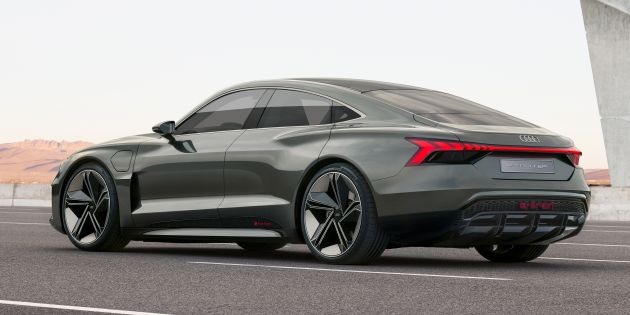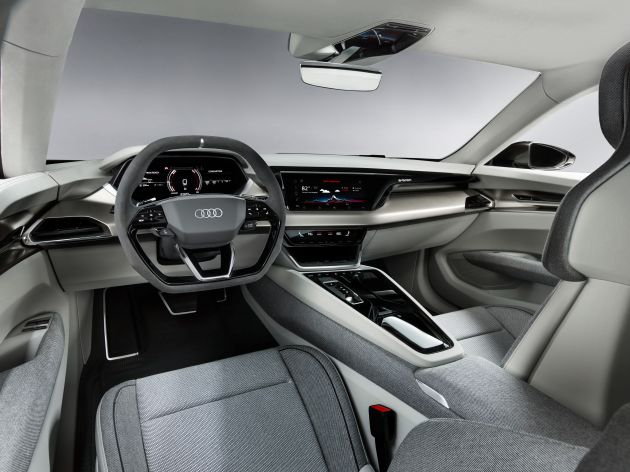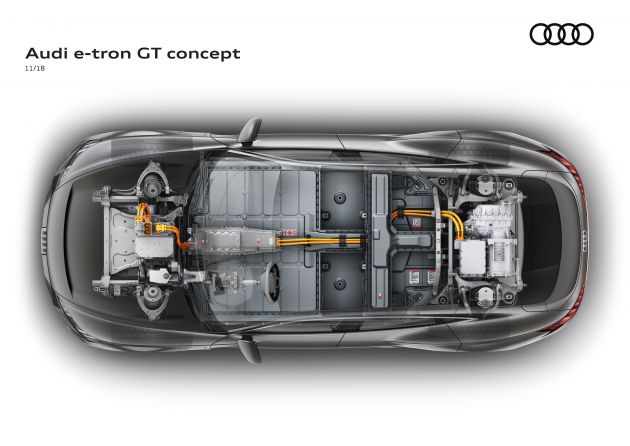Audi has made it clear that e-tron vehicles are an important part of its future, with the first being the e-tron SUV that made its global debut in September. This will be followed by a Sportback version of the e-tron, which is nice but we’re here today to talk about something even more exciting, the e-tron GT concept.
The show car is celebrating its premiere at the 2018 Los Angeles Auto Show, and it’s certainly a very striking vehicle to look at. If you like what you see, there’s more good news because Audi plans to put the e-tron GT into production by 2020, which is a lot less waiting time than that new Toyota Supra.
Anyway, the e-tron GT is described as a four-door coupe that measures 4.96 metres long, 1.96 metres wide, 1.38 metres tall and with a wheelbase of 2.9 metres. Beyond the classic gran turismo proportions, the concept features a sloping roofline that gently leads into the sportback rear.
Other exterior highlights include Audi’s trademark Singleframe grille, muscular fenders over the wheel arches, 22-inch five twin-spoke wheels with 285/30 profile tyres, as well as a unique paint finish called ‘kinetic dust’, which provides significant contrast between the body surfaces depending on the lighting.
This design is also influenced by aerodynamic requirements. For starters, you’ll find air vents on the wheel arches, while at the rear, there’s a solid diffuser. Those large air inlets at the front also serve to cool various system, and the vented hood is a nod to previous concepts like the Aicon and PB18 e-tron.
As for the lighting units, the sleek-looking front clusters feature matrix LED technology with laser high beam. Meanwhile, the rear looks to the e-tron SUV with a light strip that runs across the entire width of the rear, ending at individual wedge-shaped LED segments. This visual signature is also animated here to welcome the driver with a short sequence.
Audi says the “technology for this automobile was developed in close collaboration with Porsche,” which is just another way of saying it uses the J1 platform also found on the upcoming Taycan. The body utilises several materials, with carbon for the roof, while aluminium is used for other components and supporting elements made from high-strength steel.
Moving inside, the clean and minimalist cabin is distinctively Audi, and is clear statement of contemporary automotive design. It also looks very much production ready, although we’ll only find out if there will be any revisions in 2020.
Greeting the driver is a hexagonal-shaped steering wheel, which has “engine” start/stop and drive mode buttons located on it. Audi’s affinity for digital displays is on show as well, as you’ll find one in the instrument binnacle, another on the main dashboard for the infotainment system, and a third for the climate control system. There’s no conventional gear lever here, with buttons handling the duty of putting the car in park, reverse, neutral and drive.
Audi adds that this is a vegan interior, in that no animal-based products are used at all. In fact, a majority of the materials used are Earth-friendly, including the synthetic leather for the seats and trim; fabrics made from recycled fibres; microfibre headliner; and carpets that are made from Econyl yarn, a recycled fibre made from used fishing nets.
Despite the sporty outlook, the German carmaker says the e-tron GT “provides a large dose of everyday usability” with four seats and two luggage compartments – the one at the front offers 100 litres, while there is 450 litres in the rear.
Powertrain-wise, the e-tron GT has electric motors on the front and back axles provide quattro traction and torque vectoring. These motors provide 582 hp (434 kW), which is good for a 0-100 km/h time of 3.5 seconds, or 0-200 km/h in just over 12 seconds.
The top speed is limited to 240 km/h in the interest of range, which is about 400 km following the WLTP standard. The motors draw power from a 90 kWh lithium-ion battery that is mounted on the vehicle floor for a low centre of gravity that is comparable to the R8.
Recharging the battery can be done via regenerative braking, with the car’s recuperation system said to help increase range by up to 30% depending on the mode of operation. Up to 0.3 g, the vehicle recuperates energy solely via the electric motors, without using the conventional brake – covering for over 90% of all decelerations.
Of course, plugging the car in is the fastest way to juice up, and with an 800-volt charging system, it’ll take around 20 minutes to recharge the battery to 80% of its capacity, or a range of more than 320 km. You can still use charging points with lower voltages, or go wireless with induction charging – the latter will see a full charge overnight with a 11 kW charging output.
By 2025 Audi plans to launch 20 new models, with 12 of them featuring all-electric powertrains. Three e-tron models, including the e-tron GT, have been confirmed, and Audi says there will be a range of models with classic body layout such as Avant and Sportback on the way.
Source: Read Full Article




